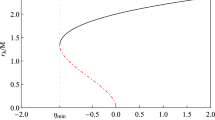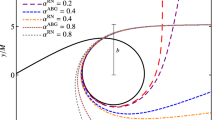Appendix A: Derivation of Eq. (35)
The scattering solution (33) of the Schrödinger equation (22) has the form
$$\begin{aligned} \psi _0(\mathbf {x})=\psi _{\mathrm{inc}}(\mathbf {x})+\psi _{\mathrm{scatt}}(\mathbf {x}), \end{aligned}$$
(60)
where \(\psi _{\mathrm{inc}}(\mathbf {x})\) and \(\psi _{\mathrm{scatt}}(\mathbf {x})\) respectively represent the incident and scattered waves and have the form \(\psi _{\mathrm{inc}}(\mathbf {x}){:}{=}\hbox {e}^{i\mathbf {k}\cdot \mathbf {x}}/2\pi \) and
$$\begin{aligned} \psi _{\mathrm{scatt}}(\mathbf {x}){:}{=}\frac{-i}{2\pi } \sum _{m,n=1}^N \hbox {e}^{i k_x a_m}A^{-1}_{mn}\, \hbox {e}^{i(k_x |x-a_n|+k_y y)}. \end{aligned}$$
(61)
In view of (8) and (60),
$$\begin{aligned} \psi _{\mathrm{scatt}}(\mathbf {x})\rightarrow \frac{\hbox {e}^{ik r}}{2\pi \sqrt{r}}\,\mathfrak {f}_0(\mathbf {k}',\mathbf {k})~~~\mathrm{for}~~~r\rightarrow \infty . \end{aligned}$$
(62)
This shows that in order to compute the scattering amplitude, we should determine the large-r behavior of the right-hand side of (61). First, we express this equation as
$$\begin{aligned} \psi _{\mathrm{scatt}}(\mathbf {x})=\frac{\hbox {e}^{ik_y y}}{2 \pi } \sum _{n=1}^N \Big [ \mathfrak {t}^+_{n}\ \Theta (x-a_n)\hbox {e}^{ik_x x} + \mathfrak {t}^-_{n}\ \Theta (a_n-x)\hbox {e}^{-ik_x x}\Big ], \end{aligned}$$
(63)
where
$$\begin{aligned} \mathfrak {t}^\pm _{n}{:}{=}-i\sum _{m=1}^N A^{-1}_{mn} \ \hbox {e}^{i k_x (a_m\mp a_n)}, \quad \Theta (x){:}{=}\left\{ \begin{array}{ll} 0 &{}\quad \mathrm{for}\, x<0,\\ 1 &{}\quad \mathrm{for}\, x\ge 0.\end{array}\right. \end{aligned}$$
(64)
For the scattering setup we consider, the source of the incident way lies at \(x=-\infty \). This implies that \(k_x>0\) and the incidence angle \(\theta _0\) takes values in the interval \((-\frac{\pi }{2},\frac{\pi }{2})\). Because the angular position of the detector is arbitrary, we take the scattering angle \(\theta \) to range over the interval \([-\frac{\pi }{2},\frac{3\pi }{2})\). Next, we introduce the notation:
$$\begin{aligned}&\theta ^+{:}{=}\theta ~~~~~~~~~\mathrm{for}~~~\theta \in \left( -\frac{\pi }{2},\frac{\pi }{2}\right) ,\\&\theta ^{-}{:}{=}\pi - \theta ~~~\mathrm{for}~~~\theta \in \left( \frac{\pi }{2},\frac{3\pi }{2}\right) , \end{aligned}$$
and employ the analysis presented in Appendix A of Ref. [28] to establish the identity:
$$\begin{aligned} \hbox {e}^{ik_y y}\hbox {e}^{\pm ik_x x} \rightarrow \sqrt{\frac{2\pi }{k r}} \ \Big [\hbox {e}^{i(kr-\frac{\pi }{4})}\delta (\theta _0-\theta ^{\pm })+\hbox {e}^{-i(kr-\frac{\pi }{4})} \delta (\theta _0-\theta ^{\pm }+ \pi )\Big ]~~\mathrm{as}~~r\rightarrow \infty . \end{aligned}$$
(65)
With the help of this relation and Eqs. (63) and (64), we obtain (62) with \(\mathfrak {f}_0(\mathbf {k}',\mathbf {k})\) given by (35).
Appendix B: Formulas for \(I_{mn}, J_{mn}\), and \(I_{mm'nn'}\)
The following are the formulas we have obtained for \(I_{mn}, J_{mn}\), and \(I_{mm'nn'}\) by performing the integrals in (46)–(48). Here, \(\alpha _n{:}{=}a_n/\sigma \), and \(\text {Erf}[x]\) and \(\text {Erfc}[x]\) are, respectively, the error and complementary error functions.Footnote 2
$$\begin{aligned} I_{mn}=&\frac{1}{8} \eta \hbox {e}^{-s \mathfrak {K}(-i {\alpha _m}+i \alpha _n+s \mathfrak {K})} \Bigg \{\sqrt{\pi } s \mathfrak {K}\hbox {e}^{(s \mathfrak {K}+i \alpha _n)^2} \\&\Big [-2 i \alpha _n^2 \lambda _2-2 \alpha _n (\lambda _2-2) s \mathfrak {K}+i \left( 8 \lambda _1+\lambda _2-2 \lambda _2 s^2 \mathfrak {K}^2\right) \Big ]\\&+2 \pi \text {Erf}[\alpha _n-i s \mathfrak {K}] \Big [2 \lambda _2+\lambda _2 s^4 \mathfrak {K}^4+\mathfrak {K}^2 (4 \lambda _1 s^2-1)\Big ]\\&-2 \pi \text {Erfc}[\alpha _n] (\mathfrak {K}^2-2 \lambda _2) \hbox {e}^{s \mathfrak {K}(s \mathfrak {K}+2 i \alpha _n)}\\&+2 \pi \Big [2 \lambda _2+\lambda _2 s^4 \mathfrak {K}^4+\mathfrak {K}^2 (4 \lambda _1 s^2-1)\Big ]\Bigg \}+\mathcal {O}(\eta ^2),\\ J_{mn}=&\frac{1}{8} \eta \hbox {e}^{i {\alpha _m} s \mathfrak {K}} \sqrt{\pi } \Bigg \{2 \hbox {e}^{-s \mathfrak {K}(i {\alpha _n}+s \mathfrak {K})} \sqrt{\pi } \left[ \mathfrak {K}^2 \left( -1+4 s^2 \lambda _1\right) +2 \lambda _2+s^4 \mathfrak {K}^4 \lambda _2\right] \text {Erfc}[{\alpha _n}-i s \mathfrak {K}]\\&-2 \hbox {e}^{i {\alpha _n} s \mathfrak {K}} \sqrt{\pi } (\mathfrak {K}^2-2 \lambda _2) \text {Erf}[{\alpha _n}]+\hbox {e}^{-{\alpha _n} ({\alpha _n}-i s \mathfrak {K})}\\&\Big [(-2 \hbox {e}^{{\alpha _n}^2} \sqrt{\pi } (\mathfrak {K}^2-2 \lambda 2)-i s \mathfrak {K}(-4+8 \lambda _1\\&-2 i {\alpha _n} s \mathfrak {K}(-2+\lambda _2)+\lambda _2+2 s^2 \mathfrak {K}^2 \lambda _2-2 {\alpha _n}^2 (4+\lambda _2))\Big ]\Bigg \}+\mathcal {O}(\eta ^2),\\ I_{mm'nn'}=&g_{mm'nn'}+\Theta (m-n)h_{mm'nn'}+\Theta (n-m)k_{mm'nn'}+l_{mm'nn'}, \end{aligned}$$
where
$$\begin{aligned} g_{mm'nn'}&{:}{=}\left\{ \begin{array}{lll} q_{mm'nn'}&{}\text {for} &{} m=n,\\ s_{mm'nn'}&{}\text {for} &{} m > n,\\ t_{mm'nn'}&{}\text {for}&{} m<n, \\ \end{array}\right. \\ q_{mm'nn'}&{:}{=}\frac{1}{4} \sqrt{\pi } \eta s \mathfrak {K}[\hbox {e}^{i s \mathfrak {K}(\alpha _m'+{\alpha _n'})}] \hbox {e}^{-\alpha _m^2-i s \mathfrak {K}(\alpha _m-{\alpha _n})-{\alpha _n}^2} \\&\Bigg [\hbox {e}^{\alpha _m^2} \left( \sqrt{\pi } \hbox {e}^{{\alpha _n}^2} s \mathfrak {K}(\text {Erfc}[{\alpha _n})-2]-2 i {\alpha _n}^2+2 {\alpha _n} s \mathfrak {K}+i\right) \\&-i \hbox {e}^{{\alpha _n}^2+2 i s \mathfrak {K}(\alpha _m-{\alpha _n})} \left( -i s \mathfrak {K}\left( \sqrt{\pi } \hbox {e}^{\alpha _m^2} \text {Erfc}[\alpha _m]+2 \alpha _m\right) +2 \alpha _m^2-1\right) \Bigg ]+\mathcal {O}(\eta ^2),\\ s_{mm'nn'}&{:}{=}\frac{1}{4} \sqrt{\pi } \eta s \mathfrak {K}[\hbox {e}^{i s \mathfrak {K}(\alpha _m'+{\alpha _n'})}]\hbox {e}^{-\alpha _m^2-s \mathfrak {K}(s \mathfrak {K}+i ({\alpha _m}+{\alpha _n}))-{\alpha _n}^2} \\&{\Bigg [\hbox {e}^{{\alpha _n}^2}} s \mathfrak {K}\Bigg (\sqrt{\pi } \hbox {e}^{{\alpha _m}^2} \Big (\text {Erfc}[{\alpha _m}-i s \mathfrak {K}]+\text {Erf}[{\alpha _n}-i s \mathfrak {K}]\\&+(\text {Erfc}[{\alpha _n}]-2) \hbox {e}^{s \mathfrak {K}(s \mathfrak {K}+2 i {\alpha _n})}-1\Big )-(\sqrt{\pi } \hbox {e}^{{\alpha _m}^2} \text {Erfc}[{\alpha _m}]+2 {\alpha _m}) \hbox {e}^{s \mathfrak {K}(s \mathfrak {K}+2 i {\alpha _m})}\Bigg )\\&+2 (-2 i {\alpha _n}^2+{\alpha _n} s \mathfrak {K}+i) \hbox {e}^{{\alpha _m}^2+s \mathfrak {K}(s \mathfrak {K}+2 i {\alpha _n})}\Bigg ]+\mathcal {O}(\eta ^2),\\ t_{mm'nn'}&{:}{=}\frac{1}{4} \sqrt{\pi } \eta s \mathfrak {K}\hbox {e}^{i s \mathfrak {K}(\alpha _m'+{\alpha _n'})} \hbox {e}^{-{\alpha _m}^2-s \mathfrak {K}(s \mathfrak {K}+i ({\alpha _m}+{\alpha _n}))-{\alpha _n}^2}\\&\Bigg [s \mathfrak {K}\left( \sqrt{\pi } \hbox {e}^{{\alpha _m}^2} (\text {Erfc}[{\alpha _m}]-2)+2 {\alpha _m}\right) \hbox {e}^{{\alpha _n}^2+s \mathfrak {K}(s \mathfrak {K}+2 i {\alpha _n})}\\&+\hbox {e}^{{\alpha _m} ({\alpha _m}+2 i s \mathfrak {K})} \Bigg (\sqrt{\pi } s \mathfrak {K}\hbox {e}^{{\alpha _n} ({\alpha _n}+2 i s \mathfrak {K})} (\text {Erf}[{\alpha _m}+i s \mathfrak {K}]-\text {Erf}[{\alpha _n}+i s \mathfrak {K}])\\&-\hbox {e}^{s^2 \mathfrak {K}^2} \Big (\sqrt{\pi } \hbox {e}^{{\alpha _n}^2} s \mathfrak {K}\text {Erfc}[{\alpha _n}]+4 i {\alpha _n}^2+2 {\alpha _n} s \mathfrak {K}-2 i\Big )\Bigg )\Bigg ]+\mathcal {O}(\eta ^2),\\ h_{mm'nn'}&{:}{=}\frac{1}{16} \eta \hbox {e}^{i s \mathfrak {K}(\alpha _m'+{\alpha _n'})}\Bigg \{12 \pi \eta (\text {Erf}[{\alpha _n}]-\text {Erf}[{\alpha _m}]) \left( 2 \lambda _2+\left( s^2-1\right) \mathfrak {K}^2\right) \hbox {e}^{i s \mathfrak {K}({\alpha _m}-{\alpha _n})}\\&+4 \pi \eta \hbox {e}^{-i s \mathfrak {K}({\alpha _m}+{\alpha _n}-i s \mathfrak {K})} \text {Erf}[{\alpha _m}-i s \mathfrak {K}] \\&\left( 4 \lambda _1+6 \lambda _2+3 \lambda _2 s^4 \mathfrak {K}^4+\mathfrak {K}^2 \left( (4 \lambda _1+3) s^2-3\right) \right) \\&-4\pi \eta \hbox {e}^{-s \mathfrak {K}(s \mathfrak {K}+i ({\alpha _m}+{\alpha _n}))} \text {Erf}[{\alpha _n}-i s \mathfrak {K}] \\&\left( 4 \lambda _1+6 \lambda _2+3 \lambda _2 s^4 \mathfrak {K}^4+\mathfrak {K}^2 \left( (4 \lambda _1+3) s^2-3\right) \right) \\&+ \sqrt{\pi } \hbox {e}^{-{\alpha _m}^2-{\alpha _n}^2} \Bigg [2 \hbox {e}^{-i s \mathfrak {K}({\alpha _m}+{\alpha _n})} \\&\Bigg (i \hbox {e}^{{\alpha _m}^2+2 i {\alpha _n} s \mathfrak {K}} \Big (6 {\alpha _n}^2 (\lambda _2+8) s \mathfrak {K}+i {\alpha _n} \left( 8 \lambda _1+9 \lambda _2+6 \lambda _2 s^2 \mathfrak {K}^2\right) \\&-s \mathfrak {K}\left( 8 \lambda _1+3 \lambda _2+6 \lambda _2 s^2 \mathfrak {K}^2\right) \Big )\\&+\hbox {e}^{2 i {\alpha _m} s \mathfrak {K}} \Big (3 \hbox {e}^{{\alpha _m}^2} {\alpha _n} (8 \lambda _1+3 \lambda _2)+\hbox {e}^{{\alpha _n}^2} \big (3 \lambda _2 s \mathfrak {K}(-2 i {\alpha _m}^2\\&+2 {\alpha _m} s \mathfrak {K}+2 i s^2 \mathfrak {K}^2+i)-16 {\alpha _m} \lambda _1+8 i \lambda _1 s \mathfrak {K}\big )\Big )\Bigg )\\&-24 i \hbox {e}^{{\alpha _m}^2} {\alpha _n}^3 \lambda _2 \sin (s \mathfrak {K}({\alpha _m}-{\alpha _n}))\Bigg ]\Bigg \}+\mathcal {O}(\eta ^2),\\ k_{mm'nn'}&{:}{=}\frac{1}{8} \sqrt{\pi } \eta \hbox {e}^{i s \mathfrak {K}(\alpha _m'+{\alpha _n'})} \Bigg \{\hbox {e}^{-{\alpha _m}^2-{\alpha _n}^2-i ({\alpha _m}-{\alpha _n}) s \mathfrak {K}} \Big (-{\alpha _m} \hbox {e}^{{\alpha _n}^2} \left( -8 \lambda _1+\left( -3+2 {\alpha _m}^2\right) \lambda _2\right) \\&+{\alpha _n} \hbox {e}^{{\alpha _m}^2} \left( -8 \lambda _1+\left( -3+2 {\alpha _n}^2\right) \lambda _2\right) \Big )\\&+ \hbox {e}^{-{\alpha _m}^2-{\alpha _n}^2-i ({\alpha _m}+{\alpha _n}) s \mathfrak {K}} \Big [\hbox {e}^{{\alpha _m} ({\alpha _m}+2 i s \mathfrak {K})} \Big (8 {\alpha _n} \lambda _1-2 {\alpha _n}^3 \lambda _2\\&+{\alpha _n} \left( 3+2 s^2 \mathfrak {K}^2\right) \lambda _2+2 i {\alpha _n}^2 s \mathfrak {K}(8+\lambda _2)-i s \mathfrak {K}\left( 8 \lambda _1+\lambda _2+2 s^2 \mathfrak {K}^2 \lambda _2\right) \Big )\\&+\hbox {e}^{{\alpha _n} ({\alpha _n}+2 i s \mathfrak {K})} \Big (2 {\alpha _m}^3 \lambda _2-2 i {\alpha _m}^2 s \mathfrak {K}\lambda _2+i s \mathfrak {K}\left( 8 \lambda _1+\lambda _2+2 s^2 \mathfrak {K}^2 \lambda _2\right) \\&-{\alpha _m} \left( 8 \lambda _1+\left( 3+2 s^2 \mathfrak {K}^2\right) \lambda _2\right) \Big )\Big ]\\&+2 \hbox {e}^{-i ({\alpha _m}-{\alpha _n}) s \mathfrak {K}} \sqrt{\pi } \left( \left( s^2-1\right) \mathfrak {K}^2+2 \lambda _2\right) \text {Erf}[{\alpha _m}]\\&-2 \hbox {e}^{-i ({\alpha _m}-{\alpha _n}) s \mathfrak {K}} \sqrt{\pi } \left( \left( s^2-1\right) \mathfrak {K}^2+2 \lambda _2\right) \text {Erf}[{\alpha _n}]\\&-2 \hbox {e}^{i s \mathfrak {K}({\alpha _m}+{\alpha _n}+i s \mathfrak {K})} \sqrt{\pi } \left( x^2 \left( -1+s^2 (1+4 \lambda _1)\right) +2 \lambda _2+s^4 \mathfrak {K}^4 \lambda _2\right) \text {Erf}[{\alpha _m}+i s \mathfrak {K}]\\&+ 2 \hbox {e}^{i s \mathfrak {K}({\alpha _m}+{\alpha _n}+i s \mathfrak {K})} \sqrt{\pi } \left( \mathfrak {K}^2 \left( -1+s^2 (1+4 \lambda _1)\right) +2 \lambda _2+s^4 \mathfrak {K}^4 \lambda _2\right) \text {Erf}[{\alpha _n}+i s \mathfrak {K}]\Bigg \}\\&\quad +\mathcal {O}(\eta ^2),\\ l_{mm'nn'}&{:}{=}\frac{1}{8}\eta \hbox {e}^{i s \mathfrak {K}(\alpha _m'+{\alpha _n'})} \hbox {e}^{-{\alpha _n}^2+i s \mathfrak {K}({\alpha _n}-{\alpha _m})} \\&\Bigg [2 \pi \hbox {e}^{{\alpha _n}^2} \left( 2 \lambda _2+\left( s^2-1\right) \mathfrak {K}^2\right) \left( \text {Erf}[{\alpha _n}]+\text {Erfc}[{\alpha _n}] \hbox {e}^{2 i s \mathfrak {K}({\alpha _m}-{\alpha _n})}\right) \\&+\sqrt{\pi } \Bigg ({\alpha _n} \left( \left( 2 {\alpha _n}^2-3\right) \lambda _2-8 \lambda _1\right) \hbox {e}^{2 i s \mathfrak {K}({\alpha _m}-{\alpha _n})}\\&+2 \sqrt{\pi } \hbox {e}^{{\alpha _n}^2} \left( 2 \lambda _2+\left( s^2-1\right) \mathfrak {K}^2\right) \\&-2 {\alpha _n}^3 \lambda _2+8 {\alpha _n} \lambda _1+3 {\alpha _n} \lambda _2\Bigg )\Bigg ]+\mathcal {O}(\eta ^2). \end{aligned}$$









